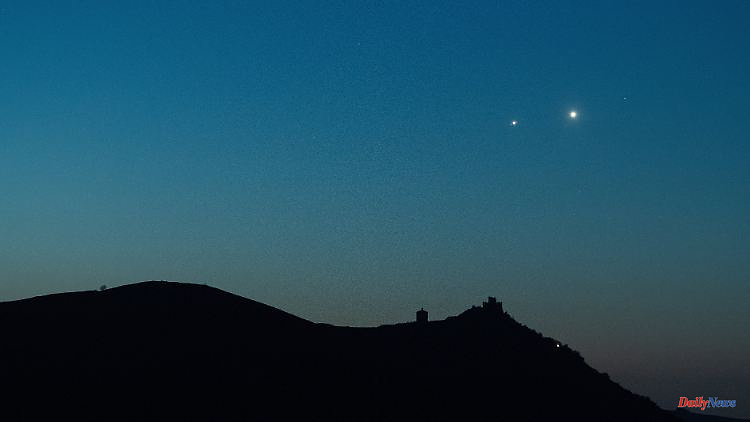The March evening sky is dominated by two planets that appear to pose for an astrophoto at the end of the month. In addition, the sky also shows that winter is slowly saying goodbye: the spring constellations are arriving.
The two brightest planets dominate the evening starry sky in March. Venus can be seen in the southwest shortly after sunset. Jupiter, the second brightest planet, will soon appear. At the beginning of the month, the planetary race from the previous month is over. Already on March 2nd, Venus will overtake the giant planet Jupiter just one full moon latitude north. By March 23, their distance has grown significantly: On this day, the crescent of the waxing moon stands between the two planets. A pretty sight that encourages you to take an astrophoto.
Venus expands its position in the evening sky. She becomes a conspicuous star that draws attention, even from contemporaries who are otherwise hardly interested in heavenly events. While Venus can be seen longer and longer in the evening sky, Jupiter shortens its visibility time. At the end of the month it changes to the daytime sky and becomes unobservable. Then, in late May, Jupiter reappears low in the eastern sky in the morning.
Mars will dimmer by almost a magnitude over the course of the month. Although it is not nearly as bright as Venus and Jupiter, it is still one of the brightest stars in the night sky. The reddish planet transits the constellation of Taurus, entering Gemini on March 26th. The decrease in Martian brightness can be followed well on Aldebaran, the orange main star of Taurus, whose brightness remains constant. At the end of March, both stars are equally bright. On the 28th, the waxing crescent moon visits Earth's reddish neighboring planet.
At the end of the month, experienced observers and astronomers can spot Mercury, which is close to the Sun, with powerful binoculars and a stable tripod. About half an hour after sunset you have a chance to find Mercury.
Full Moon is reached on March 7th at 1:40 p.m. in the constellation Leo. The moon is close to Regulus, the bluish main star of Leo. Already on the 3rd the moon will be 405,888 kilometers away from Earth. In March, on the 31st, he comes a second time at a distance of 404,919 kilometers. On the 19th, it will be just 362,696 kilometers from it when it passes its closest point. The new moon phase occurs on the 21st at 6:23 p.m.
Winter is drawing to a close against the starry sky in the evening. The mighty Orion and the strikingly bright radiant Sirius in the southwest still attract attention. The bull with the red Aldebaran can also still be found halfway up in the west. In the east, however, the march of spring pictures has begun. Leo, the beacon of spring, begins its leap through the meridian. The constellation of Virgo has risen in the southeast, also a typical spring image.
South of Leo and west of Virgo is a trapezoidal square of stars. It is to mark the raven. According to legend, the raven had snow-white feathers and could sing beautifully. Apollo sent the raven to a spring to get water from a cup and bring it to Mount Olympus for the company of the gods. But the defaulting raven was considerably late and came back with an empty cup. As an excuse, he claimed that a water snake had emptied the spring. As punishment, he received black plumage and a raspy voice. All three were placed in the starry sky for eternal remembrance: raven, cup and water snake.
The sun travels through the zodiac on the ascending branch of its annual path. Late in the evening of the 12th, she leaves Aquarius and enters Pisces, crossing the celestial equator on the 20th at exactly 10:24 p.m. Their change from the southern to the northern hemisphere of the celestial sphere marks the astronomical beginning of spring. Thus, on the 20th, the vernal equinox occurs.
Central European Summer Time starts on Sunday, March 26th. At 2 a.m., the clocks are put forward one hour. Daylight Saving Time begins on March 12 in most US states.












